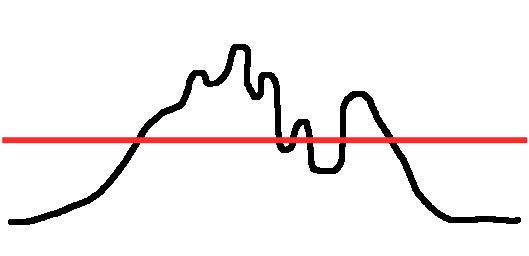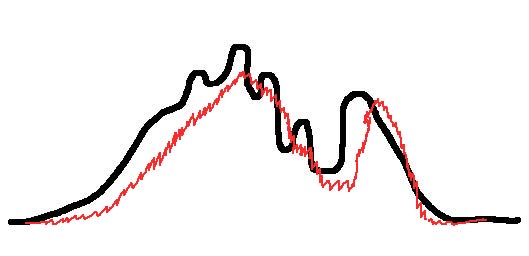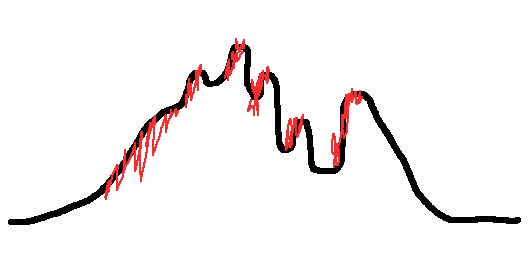Noise, Kinds of Noise and Micro-dynamics
[Sorry about the peek-a-boo with the last post. We should be able to repost it any day now – certainly before CES :-)]

Here is our silly picture of a note once again, in all its pure pristineness

This is persistent background noise, like tape hiss.

This is background noise that gets louder as each note gets louder.

The is background noise that is about 3dB, say, below the average volume of the notes, along with a little delay. Notice how this eats into the micro-dynamics. The delay could be caused by everything from slow discharging electronics to room echos.

This is yet another kind of noise that just kind of throws a lot of garbage into each part of the note, making it sound less distinct and pure than it should.

This is another kind of noise that appear on steep leading edges of notes.
We’ve all certainly heard all these types of noise, and more.
One thing we can say for certain about all these types of noise is that they are annoying [that’s why we call it NOISE :-)] and distracts from any drug-like effect we are trying to achieve.
We talk about the importance of micro-dynamics to achieve any drug-like effect – but as we can see [kind of] the absence of many types of noise is often required before we can even begin to HEAR micro-dynamics [assuming we have any to hear].
In other words, in order for any micro-dynamics to even show up against the background sound, we need the music to be fairly well-behaved: not too much noise, not bright and edgy, not rolled off, not drowned out by bass, delays not too long that they interfere with the micro-dynamics of the other notes, delays not too short that they distract our ears – acting like faux micro-dynamics in themselves., etc.
This kind of rules out a lot of systems from being drug-like contenders.
But it also rules in quite a few components.
As a wild-eyed [or sleepy-eyed] guess, I’d say:
40-60%? of speakers should be flat enough in the midrange and not extremely terrible in the outer freq to qualify as well-behaved
40%? or so of small tube amps as well
5%? of large tube amps
10%? of solid-state amps
20%? of preamps
20%? of CD players
90%? of turntables
20%? of cables
The rest are too bright or blurred, frequency shifting, compressive, too much NOISE, or whatever…
[Note that it is important, as always, to match amp to speaker. Incorrectly matched amp/speaker pairs will have a much smaller chance of achieving a drug-like sound. I would say ZERO chance except in the (not uncommon) case where a small tube amp – say a 2A3-tube based amp – is paired with a good but not terribly efficient speaker in order to get the drug-like effect in a very narrow freq range – the rest of the freq being out to a very long lunch.].

I would question the 40-60% of speakers. Many speakers (particularly those with cone drivers require that the sound reach a threshold before you actually hear much detail. In many instances, any detail or content which is below that loudness threshold is lost in whole or in part. This typically manifests itself in the phenomenon that you must play a particular speaker at a certain threshold level before it sounds good. Generally, there is some sorrelation between efficiency of a driver/speaker and this phenomenon. Thus horns often do low level detail well. The converse of this is elctrostats which are not normally that efficeient but often score high on micro detail. I suspect that the complexity of the crossover and the number of elements may also impact this.
Hi Fred,
When I came up with the 40-60% number, thinking of high-end audio loudspeakers, I thought of a kind of pass/fail test:
Sonus Faber – pass. how they do at least minimally well in the mids to upper-mids, I thought of
QUAD – pass. which is similar and that it also rolls off the freq extremes
Avalon – pass. bass is hard to drive but otherwise they do fine
B&W – fail. which fails because it exaggerates the freq extremes.
Focal – fail, [I think a few might at the top of the line pass] because the mids are messed up, or it exaggerates the freq extremes
Wilson – pass [with attention paid to how it tends to exaggerate the freq extremes
…
So, you are thinking of maybe the Magico, YG Acoustics, older JM Lab, Green Mountain Audio, Venture… ?
And, on the other hand, many quite efficient cone speakers use inferior drivers and or crossovers so that their mids are very uneven or missing much low level detail: for ex: Dunlavy [missing detail] and lesser known one-off brands.
The better horns do midi-dynamics well but rarely do micro-dynamics well, if we can differentiate down at the level of fine detail. Rethm and Edgarhorn for example. And even with the best horns one might wish [perhaps many thousands of times ;-)] for better, more detailed drivers to get just a little more of that fine micro-dynamic detail.
Maybe the problem with my 40-60% number is that I am thinking of these speakers being paired with the best possible amps [KB, Ongalu, Gaku-On, ML3, etc ;-)] – but if one looks at driving them with a commensurately priced amp…, then we are probably down to, what, 20%? Less?
Hmmm… I concede your point.
Take care,
-MIke
I got to thinking about your general comments on this topic before returning to the blog and seeing the Mike/Fred exchange, two items of which caught my attention and feed into my issue, which is scale of reproduction. First the initial generalizations, on clarification were apparently restricted to high end speakers, and then followed up with additional restrictions associated with highest end amplification…a narrow field for system owners. Second, Fred raises the question about some speakers having dependencies on a certain minimal volume threshhold above which they might be in the coveted group. I was wondering regarding the converse (or inverse?) on the minimalist side and would be curious to get some feedback. I mean minimalist in total system size (and presumably cost) to put out Grade A if not reference quality sound from the microdynamics standpoint. Lets assume you have a Grada A or reference quality digital source, headphone amp, and headphones, with appropriately matched interconnects. Does that not provide an avenue to accurate reproduction with microdynamics over 90% of the audible frequency? Presuming some low end limitations, and perhaps punch here and there? Is there any necessary relationship between speaker size/weight (inches? pounds?)and output volume that would allow for Grad A sound unless you needed more output volume I’m imagining a new ranking scale where you would cover all high end output capable sysems from small scale to large (but I’m especially interested in who gets admitted to the club if any at the small end, starting with headphones). I’ve got the impression whlle listening to the Sennheiser 800 at times, particularly on, say, Mozart..that the detail and accuracy of reproduction was pretty good when listening at bearable headphone sound levels. And I’ve heard a number of systems that sound fairly decent until you turn up the volume and they totally fall apart, or they fall apart in certain frequencies. Is there any pattern here? Are there any small scale playback systems that, setting aside high volume and discounting for limitations covering the 32′ Bach organ pipes and 1812 Overture cannons, can produce for somewhat less than $100k total (alot less even?) the sound we’re all desiring? Is BIG always better than small or can they be of equal quality aside from volume?
Hi Jim,
[You have a lot of questions there, Jim :-)]
My initial attempt to determine the percentage of drug-like capable speakers, immediately above, was 1) focused on the high-end [i..e not Bose, Definition, Monitor Audio etc. which, face it, are the most popular speakers sold, but including B&W, Vandersteen, etc] and 2) whether they were CAPABLE of ever being drug-like.
In a large sense, this whole ‘drug-like’ sound discussion on this blog lately has been focused on the ‘low end’. At the price what price? level we can, and have, thrown together Gaku-Ons and ML3’s and DAC 5 Signatures and XDS1’s and ODIN etc. and we experience drug-like sound of several varieties. Here we are trying to work backwards and figure out 1) if there are different kinds of drug-like sounds [yes, but so far we just talk about heart—mind] and 2) how we can purposely design for these different kinds and 3) how we can isolate the important properties of these kinds so that 4) we can design systems to achieve drug-like sound at a lower cost.
If you look at the percentages, immediately above, the probability of a monkey [average audiophile or dealer] putting together a system that produces drug-like sound is the cross-product of all the probabilities, in other words I think we multiply them all together and multiply by 2 [because order of purchase is irrelevant. Steve G., if you are out there, let me know if I am wrong]. Assuming speakers are at 20% [given an average amp] that is 2 * 0.2 * 0.2 * 0.1 * 0.2 or a chance of 1 out of 625 in getting a solid-state digital drug-like system.
As for scale, I pretty much assume small scale for most of this discussion. Mostly because if we consider large scale drug-like systems then we are really only able to talk about systems with very specific [I count 9] very expensive speakers [there may be a few others, but their pedigree is so focused on the Boy Toy, it would only be by accident that they could actually be drug-like]. So, to try and include lower end systems, and because absolute bass and scale is not something that we have all decided is not NECESSARY for a drug-like sound, we are, yes, ignoring scale for the time being.
“…systems that sound fairly decent until you turn up the volume and they totally fall apart, or they fall apart in certain frequencies. Is there any pattern here?”
Yes, this does seem to happen frequently. Sometimes it is the amp being over driven, or discordant room interactions becoming much more audible… But it can also be that the problems were always there, just not as audible and just not as blasted ANNOYING. There is various SPLs above which something that we could ignore at a lesser SPL becomes really irritating. Many people turn up the system much louder than they normally might when they are getting a system demo – or at a show – just to be sure that problems like this do not go unnoticed. Kind of like driving a car much faster than you normally might [well, OK, OTHER people normally might :-)] during a test drive to see how the car really handles bumps and cornering at speed and so getting a better ‘feel’ for what the car can do [over steer, under steer, lean etc.] One should also test as well at lower volumes – which many people FORGET – in order to make sure that quiet passages also are rendered well [as Fred commented on above].
Well, I hope this addressed some of your points….
Take care,
-Mike
When you spoke of large scale drug-like systems, you mentioned that you could count 9. Should I assume that these are the 9 systems mentioned in your eralier Boy Toys article?
Hi Fred,
Hmmm…. in the comment immediately above, the ‘9’ was referring to ‘very expensive speakers’. The idea is that all drug-like large scale systems would require a pair of these at a minimum. That the cost of these speakers, by themselves, are out of the reach of sane folk. Ergo all large scale drug-like systems are out of the reach of sane folk.
This discussion is therefore primarily about medium and small scale drug-like systems that might be of interest to people other than just me, you and Jim – who all happen to have one of the nine speakers I can think of that can do large scale presentations with sufficient micro-dynamics and enough realism to have a chance at being drug-like.
So, yeah, I count 9 +/- depending on what ‘large scale’ means. For example, I include the Wilson Alexandria, but should we include the MAXX 3? [Jim would say not :-)]. I include the Acapella Trilons and maybe the Campanile – but the Sphaerons are too rare a beast to include. Similarly with the Avalon Sentinels. Also the Marten Coltrane Supreme and Momento speakers. The Kharma Grande Exquisite and midi-Grande Exquisite – but probably not the Exquisite, being a little short. The big Focal is a question mark for me [it is big enough but can it produce micro-dynamics? It troubles me that they have to always pair it with huge amps]. The Avantgarde Trios have issues, but with a little 2A3 amp and a little care…
Any others? Everything else I can think of can’t correctly be driven even by the biggest amps and/or has sufficiently bad behavior to exclude it from the list.
Take care,
-Mike
OK. To complete this thread…
Good speakers that can produce a large-scale presentation that I think need to be ruled out because they are so difficult to drive, preventing micro-dynamics or only allowing micro-dynamics at high volumes:
* PeakConsult, Magico, YG Acoustics, Rockport
Speakers that can produce a large-scale presentation that I think need to be ruled out because they have midrange ‘issues’ of one sort of another:
* KEF [their statement model], Edgarhorn, PHC, Classic Audio Reproductions horns, Dali, Genesis, Wisdom Audio
Speakers that are large but which I do not think present large-scale presentations:
* Most electrostatics and planer speakers
Speakers which may or may not have enough of what we are looking for if we are going for a large-scale drug-like sound:
* Focal [the latest powered-woofer statement model], Avantgarde [the latest sturdier frame models], Soundlab [the latest high-efficiency models],
Speakers which I do not have enough information to determine if they might work or not:
* JBL, Alon
OK, on to medium and small scale drug-like systems [where our speaker choices expand quite a bit]…. and small tube amps…!